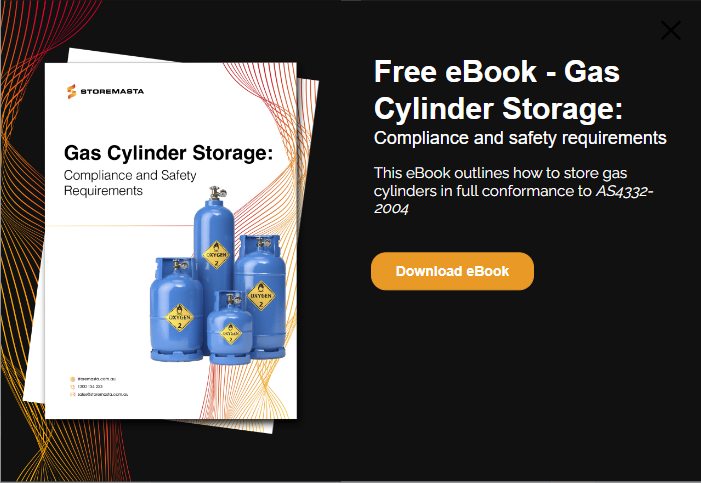Liquefied Petroleum Gas (LPG) stored in cylinders is used in workplaces all over Australia. But because LPG is also one of the most common household fuels, it’s easy to forget that LPG is actually a Class 2.1 flammable gas and classified as a Hazardous Chemical and a Dangerous Material.
In this blog we’ll be looking at the specific requirements of the regulations (listed below) as they relate to the storage of LPG cylinders and flammable gases.
- AS 4332—2004 The storage and handling of gases in cylinders
- NOHSC:2017(2001) Storage and Handling of Workplace Dangerous Goods
IMPORTANT: When we talk about ‘regulations’ in this blog we are referring to the legislation, Codes of Practice, and Australian Standards that regulate how LPG cylinders should be safely stored. Even though Standards themselves are voluntary, they are considered an important part of regulatory compliance.
Storing LPG cylinders
There are three essential elements to safely storing LPG cylinders (as well as other flammable gases). We’ll be discussing each of these in detail, referring to regulation guidelines. These three essential elements are:
- Finding a safe location at the worksite for your cylinder stores (preferably outdoors)
- Segregating and separating flammable gases from toxic gases and oxidisers
- Making sure your cylinders are kept in a secure gas bottle cage
NOTE: If you handle/store less than 500 litres of LPG (combined with other Class 2.1 Flammable Gases) you should apply the specifications of AS 4332—2004 Section 2. Minor Storage to your cylinder stores.
1. Location
Wherever possible, LPG cylinder stores should be located outside. LPG bottles are vulnerable to leaks and explosions, and both of these scenarios are exacerbated in an indoor environment. LPG is not only extremely flammable, but it is denser than air, as well as an asphyxiant. What this means is any leaked gas will begin to collect in low lying areas and can either asphyxiate persons entering the area or explode.
The best location will be a level area outside and away from:
- Plant or production operations that generate heat
- Outdoor machinery and traffic
- Ignition sources including static electricity
- Combustible materials, vegetation and refuse
- Building windows, doors, air vents and ducting
QUICK TIP: Check out our recent blog LPG Gas Bottle Location Regulations for a more detailed explanation on how to find the best location onsite for your LPG cylinders.
2. Segregation and Separation
LPG and other flammable gases must be segregated by at least 3 metres from Oxidisers and Toxic Gases. You can do this in 2 ways: either physically locate them 3 metres apart, or build a screen wall from materials that are non-combustible and impervious to gas vapours.
Additionally full and empty tanks must be separated, and the empty cylinders treated in exactly the same way as if they were full. So they need to be appropriately labeled and segregated according to their dangerous goods classification and handled safely.
IMPORTANT: A segregation screen wall must stand at least 1 metre taller than the highest cylinder in the LPG store.
3. Cylinder Stores
LPG cylinders must be stored upright with their valves closed, attachments and appliances removed, and safety caps in place. You must also prevent them from falling or being knocked over as well as from anything that might damage the valve (like being hit by a forklift).
The best way to achieve all of this is to restrain each of your LPG cylinders with chains or safety straps. Then keep them inside a gas bottle cage made from heavy duty materials, with bump rails and tamper-proof locking.
REMEMBER: You can purchase compliant LPG gas bottle storage cages from Storemasta. Our Tasmanian-built storage equipment meets all requirements of the Australian Standards.
All cylinder stores require safety data sheets (SDSs) for each of the gases plus first aid equipment suitable for addressing any of their health hazards. Because LPG and flammable gases are also classed as a Hazardous Chemicals and Dangerous Goods, you’ll require a Hazardous Chemical Manifest with information for emergency services. These should all be stored close by and staff must know how to locate them quickly.
LPG cylinder stores must contain mandatory warning signs including the labels on the cylinders themselves as well as hazard statements, pictograms and placards. Always refer to the WHS Regulation current in your state or territory as well as the Code of Practice for Labelling of Workplace Hazardous Chemicals released by SafeWork Australia for signage requirements.
QUICK TIP: Refer to our detailed blog Mandatory Signs for Hazardous Chemicals Stored at Your Workplace.
Cylinder stores are always NO SMOKING areas and must be kept well ventilated. This can be achieved by natural ventilation (outdoor stores, windows, doors) or with a mechanical ventilation system (exhaust fans, ducting). Whichever method you choose you must ensure that:
- Safe oxygen levels are maintained at all times
- Gas exposure standards are safe and within explosive limits
Depending on the size of your operations, the amount of LPG handled and stored onside, and the amount of workers in contact with the gas, monitoring controls may also be required.
IMPORTANT: Entry points and emergency exits in LPG cylinder stores must be kept clear at all times.
Next Steps for LPG Safety
If you’re not 100% clear about how to safely store LPG cylinders and other flammable gases at your workplace, why not download our free eBook Gas Cylinder Storage: Compliance and Safety Requirements. We unpack AS 4332—2004 into easy-to-read text and illustrate key points with real-world case studies and examples. Download it today by clicking on the link below:
Joining the team as a Dangerous Goods Storage Consultant, Melissa Hampton became Storemasta's Marketing Manager in late 2021. With extensive knowledge and experience in chemical compliance, Melissa is responsible for leading the Marketing team and helping shape their marketing strategy. In her spare time, you can find Melissa hiking, swimming and enjoying the great outdoors in beautiful north-west Tasmania.
